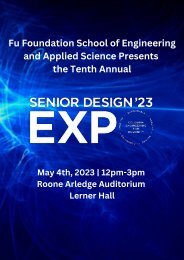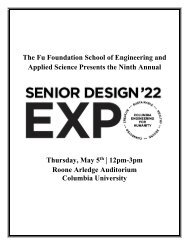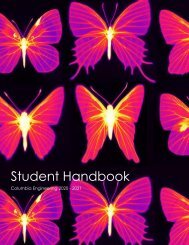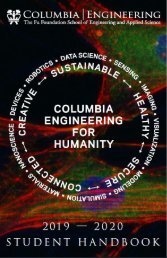Senior Design Expo 2019
The Senior Design Expo, held annually in May at Columbia University, is an opportunity for Columbia Engineering students to showcase what they have learned in their foundational math and science courses together with their engineering courses in innovative, creative, and purposeful designs and prototypes. Each year the Expo showcases more than 60 projects across all nine departments. Projects have included cutting-edge robotics, the New York City subway system, language technology, proposals for bridges to span the Hudson river, and much more.
The Senior Design Expo, held annually in May at Columbia University, is an opportunity for Columbia Engineering students to showcase what they have learned in their foundational math and science courses together with their engineering courses in innovative, creative, and purposeful designs and prototypes. Each year the Expo showcases more than 60 projects across all nine departments. Projects have included cutting-edge robotics, the New York City subway system, language technology, proposals for bridges to span the Hudson river, and much more.
Create successful ePaper yourself
Turn your PDF publications into a flip-book with our unique Google optimized e-Paper software.
VisaVein<br />
Aubrianna Queen, Saiti Srabonti, Luke Thorsell, Zarmeen Mussa<br />
Advisor: Prof. Barclay Morrison<br />
Venipuncture is the most common invasive medical procedure worldwide, yet nurses and<br />
phlebotomists often have difficulties locating the vein and inserting the needle correctly -<br />
particularly in pediatric patients who have poorly visible veins. Only 42.8% of pediatric needle<br />
insertions are successful on the first attempt. Incorrect insertions in children can lead to pain, nerve<br />
damage, and tissue necrosis. Existing assistive venipuncture devices often only provide 2-D<br />
information about vein location, leaving providers and patients susceptible to needle over<br />
insertion, a prevalent venipuncture failure mode. Our device proposes a two-pronged solution:<br />
vein visualization using tissue illumination and determination of successful insertion depth using<br />
a force transducer coupled to the needle. After initial testing, it was concluded that our device<br />
facilitates visualization of veins while the force feedback system provides critical depth<br />
information, providing comprehensive information for caregivers during needle insertion.<br />
CEA Solution<br />
Maveric Abella, Emily Chen, Diana Lu, Lorenzo Talbot-Foote, Leah Zheng<br />
Advisor: Prof. Clark Hung<br />
Postpartum hemorrhage (PPH) is the leading cause of maternal death in the world, with 99% of<br />
PPH-related mortalities occurring in low- and middle-income countries. Symptoms of PPH are<br />
difficult to distinguish during and after labor. Visual estimation of blood loss is the most practiced<br />
diagnostic technique, but this method requires continuous monitoring by healthcare personnel and<br />
fails to efficiently and successfully direct, collect, and quantify fluid, resulting in inaccurate<br />
estimations of blood loss. When hemorrhaging occurs, physicians must navigate diagnosis of PPH<br />
as quickly as possible to save patients’ lives. Therefore, there exists a need for a device that can<br />
monitor and diagnose PPH in the critical 24 hour post-delivery period when mothers are<br />
particularly susceptible to PPH. The CEA solution facilitates accurate collection and quantification<br />
of blood loss, and alerts healthcare personnel to the onset of PPH.<br />
22








